
Asia Africa and Middle East: Asian Enchantments Voyage
Regent Seven Seas Cruises
A study in contrasts, Asia takes you from the Cu Chi tunnels built for the Vietnam War to Yangon's bejeweled Shwedagon Pagoda and from Mumbai's ancient rock-cut Elephanta Caves to Singapore's thoroughly modern Gardens by the Bay.

All onboard gratuities
Select complimentary shore excursions**
Unlimited beverages, including fine wines and premium spirits served throughout the ship
In-suite refrigerator replenished daily with soft drinks, beer and bottled water
24-Hour room service
No charge for specialty restaurants
Welcome bottle of Champagne
$100 Shipboard credit (per suite)††
Executive Member Benefit
Executive Members receive an annual 2% Reward, up to $1,000, on qualified Costco Travel purchases
Executive Members receive an additional $100 shipboard credit per suite (not combinable with certain past-guest discounts)††
Digital Costco Shop Card
Member Exclusive: Digital Costco Shop Card with every Regent Seven Seas Cruises® sailing†
Sailing Itinerary

Note: Cruise itineraries are subject to change. Please verify ports and times directly with the cruise line.
Overview
Hong Kong is a place of contrasts. Sleek, glassy skyscrapers shine above Old World markets where chicken feet and dried squid are displayed for sale. Archaic wooden boats bob past sleek cruise liners. Subway stations and expressway interchanges dot a landscape cluttered with Rolls Royces and rickshaws. Hong Kong Island was ceded to Britain in 1842 when those serving the British crown attacked the island. Though it was deeded back to China in 1997, Hong Kong enjoys a high degree of autonomy, especially in its economy and municipal government. Hong Kong is one of the most unique Chinese cities in the world. The 417-square mile island off the coast of China offers visitors a slice of authentic Chinese culture with all the amenities of home. A modern metropolis teeming with eastern and western influences, Hong Kong is the world's third-largest financial center, the so-called “Wall Street of Asia,” and a shopping gold mine. Shopping? Yes indeed. Hong Kong is a duty-free port and the world's leading exporter of toys, garments, watches, and electronics. As a result, the vast majority of the 10 million annual visitors come with an empty suitcase that they fill up after visiting the malls, street bazaars (Stanley Market is world famous), textile and tailor shops, and jade and electronic stores. Those willing to look beyond the bargain-basement prices will find that Hong Kong is more than the world’s largest department store – it’s a cultural Mecca with wining and dining, museums, and historic attractions. Be sure to ride the world famous Star Ferry across the harbor to Hong Kong Island, admire the mansions on Repulse Bay, drop in to see the temples on Cat Street, visit the fishing boats and villages in Aberdeen, and take a tram ride up to Victoria Peak (the island’s highest peak sitting 1,308-feet above the city) for a stunning panoramic view. If you have time to go further, travel to Macau, a former Portuguese colony with a casino, and the New Territories of China, a Hong Kong bedroom community that “sleeps” near China’s border.
Overview
Taiwan, officially the Republic of China, is a state in East Asia. Its neighbors include the People's Republic of China to the west, Japan to the northeast, and the Philippines to the south. It is the most populous state and largest economy that is not a member of the United Nations.
Overview
Ishigaki is a city on Japan’s Ishigaki Island and a jumping-off point for beaches and coral reefs. Near the port, the Misakicho¯ district is home to the covered Euglena Mall. The Yaeyama Museum chronicles the history of Ishigaki and the other Yaeyama Islands. Connecting to a small island park, the Southern Gate Bridge offers views over the coastline. East of the city is Maezato Beach, a popular water sports hub.
Overview
Shanghai, on China’s central coast, is the country's biggest city and a global financial hub. Its heart is the Bund, a famed waterfront promenade lined with colonial-era buildings. Across the Huangpu River rises the Pudong district’s futuristic skyline, including 632m Shanghai Tower and the Oriental Pearl TV Tower, with distinctive pink spheres. Sprawling Yu Garden has traditional pavilions, towers and ponds.
Overview
Shanghai, on China’s central coast, is the country's biggest city and a global financial hub. Its heart is the Bund, a famed waterfront promenade lined with colonial-era buildings. Across the Huangpu River rises the Pudong district’s futuristic skyline, including 632m Shanghai Tower and the Oriental Pearl TV Tower, with distinctive pink spheres. Sprawling Yu Garden has traditional pavilions, towers and ponds.
Overview
Shanghai, on China’s central coast, is the country's biggest city and a global financial hub. Its heart is the Bund, a famed waterfront promenade lined with colonial-era buildings. Across the Huangpu River rises the Pudong district’s futuristic skyline, including 632m Shanghai Tower and the Oriental Pearl TV Tower, with distinctive pink spheres. Sprawling Yu Garden has traditional pavilions, towers and ponds.
Overview
Busan/Pusan is Korea's second largest city. Tourists often come to this region to hike and to visit the Buddhist Temples located deep within the region's mountains. The Beomeosa Temple, founded in 678 AD, is perhaps one of the most frequented temples in the area and is always packed with worshipers and tourists. For art buffs, Busan offers several museums and historical buildings. If scenery is your thing, try visiting the Dongbaek Island, or bird watch at the Nakdong river estuary.
Overview
Nagasaki is the capital and the largest city of Nagasaki Prefecture located at the south-western coast of Kyushu. Nagasaki lies at the head of a long bay which forms the best natural harbor on the southern Japanese home island of Kyushu. The main commercial and residential area of the city lies on a small plain near the end of the bay. Two rivers divided by a mountain spur form the two main valleys in which the city lies. The heavily built-up area of the city is confined by the terrain to less than 4 square miles out of a total of about 35 square miles in the city as a whole. The city was rebuilt after the war, albeit dramatically changed, as any city would be after such colossal damage. New temples were built and new churches as well, since the Christian presence never died out and even increased dramatically after the war. Some of the rubble was left as a memorial, such as a one-legged torii gate and a stone arch near ground zero. New structures were also raised as memorials, such as the Atomic Bomb Museum. Nagasaki remains first and foremost a port city, supporting a rich shipping industry and setting a strong example of perseverance and peace.
Overview
Kagoshima is a bright sunny tropical city. Tourists can see smoke coming from the magnificent Mt. Sakurajima across Kinko Bay. The city has been known as the Naples of the Orient for many years. It prospered as a castle town of the powerful Lord Shimazu, who had 770 thousand "koku" of rice during the Edo Period. The city still maintains the strong spirit of Takamori Saigo and Toshimichi Okubo, heroes of the Meiji Restoration. The most famous historical spot related to them is the extensive Iso Garden, former villa of Lord Shimazu. The garden´s pond is representative of Kinko Bay, which is north of downtown, and the hill is representative of Mt. Sakurajima. Sightseeing spots in the city are mostly related to Lord Shimazu and Takamori Saigo. Tsurumaru Castle (Reimei Hall), where Lord Shimazu lived, the great view from Shiroyama, where the last fort of the Saigo army was located during the Satsuma Rebellion, Nanshu Cavern, where Saigo barricaded himself, Nanshu Cemetery, where the dead from the Satsuma Rebellion are buried, and the high-tech Museum of the Meiji Restoration (Ishin Furusato-kan) are located along the Kotsuki River. The museum has information about places where Saigo, Okubo, Iwao Oyama, and Heihachiro Togo were born. Tenmonkan in the downtown area offers all types of souvenirs, including Kagoshima dishes such as sakezushi, pork bone, and kibinago, as well as shochu, Kagoshima Ramen, Satsumayaki, satsumaage, and karukan.
Overview
As a center of river and sea transportation called the City of Water, Osaka has engaged in active exchanges not only with other parts of Japan, but also with the Chinese Continent and the Korean Peninsula. Naniwazu.In the mid-7th century, an area in Osaka was designated capital of Japan; the area prospered as Japan's oldest city. Even after the capital was moved first to Nara, then to Kyoto, Osaka, as a key point in foreign trade, continued to play an important role in the development of Japan and the international exchange of culture.In the Middle Ages, Osaka developed as a temple town where Ishiyama Honganji Temple was located; during this period, Osaka served as a key point in the itinerary of pilgrims.In early modern times, the City grew into Japan's center of commerce and distribution. During this period, Osaka came to be characterized by enterprising and free-thinking merchants, and art and culture flourished in the City, where bunraku, kabuki and other traditional arts developed.As indicated above, Osaka is a city with precious historical and cultural heritages.As Osaka develops into an international tourist city, loved by people from around the world, it is hoped that many people will gather here for recreation, and become regular visitors to the City. Osaka welcomes tourists as a city with advanced technology, refined food culture, and shops with goods from around the world. Come visit Osaka for its many charms, and enjoy a holiday in the City that is just for you.
Overview
As a center of river and sea transportation called the City of Water, Osaka has engaged in active exchanges not only with other parts of Japan, but also with the Chinese Continent and the Korean Peninsula. Naniwazu.In the mid-7th century, an area in Osaka was designated capital of Japan; the area prospered as Japan's oldest city. Even after the capital was moved first to Nara, then to Kyoto, Osaka, as a key point in foreign trade, continued to play an important role in the development of Japan and the international exchange of culture.In the Middle Ages, Osaka developed as a temple town where Ishiyama Honganji Temple was located; during this period, Osaka served as a key point in the itinerary of pilgrims.In early modern times, the City grew into Japan's center of commerce and distribution. During this period, Osaka came to be characterized by enterprising and free-thinking merchants, and art and culture flourished in the City, where bunraku, kabuki and other traditional arts developed.As indicated above, Osaka is a city with precious historical and cultural heritages.As Osaka develops into an international tourist city, loved by people from around the world, it is hoped that many people will gather here for recreation, and become regular visitors to the City. Osaka welcomes tourists as a city with advanced technology, refined food culture, and shops with goods from around the world. Come visit Osaka for its many charms, and enjoy a holiday in the City that is just for you.
Overview
Blessed with a mild climate throughout the year, Shimizu is known for producing mandarin oranges, tea, and strawberries. On the coast, there is a pine-tree grove on a sand spit called Miho no Matsubara and which is often mentioned in legends. From the small mountain called Nihondaira tourists can enjoy a superb view of Mt. Fuji and the light-filled city at night. Picking strawberries during the winter and spring months is a popular pastime.
Overview
Describing Tokyo to someone who has never been here is a formidable task. After all, how do you describe a city that--as one of my friends visiting Tokyo for the first time put it--seems like it's part of another planet? To be sure, Tokyo is very different from Western capitals, but what really sets it apart is its people. Approximately 12 million people reside within Tokyo's 1,200,000,000 sq. km (800 sq. miles), and almost one-fourth of Japan's total population lives within commuting distance of the city. This translates into a crush of humanity that packs the subways, crowds the sidewalks, and fills the department stores beyond belief. In some parts of the city, the streets are as crowded at 3am as they are at 3pm. With its high-energy, visual overload, Tokyo makes even New York seem like a sleepy, laid-back town. And yet, despite its limited space for harmonious living, Tokyo remains one of the safest cities in the world, with remarkably little crime or violence. No matter how lost I may become, I know that people will go out of their way to help me. Hardworking, honest, and helpful to strangers, the Japanese are their country's greatest asset. With Tokyo so densely packed, it comes as no shock to learn that land here is more valuable than gold and that buildings are built practically on top of each other, shaped like pieces in a jigsaw puzzle to fit the existing plots of real estate. More than perhaps any other city in the world, Japan's capital is a concrete jungle, with a few parks but not many trees to break the monotony, and it stretches on and on as far as the eye can see. Fires, earthquakes, wars, the zeal for modernization, and the price of land have taken their toll on the city, eradicating almost all evidence of previous centuries. It's as though Tokyo was born only this morning, with all the messy aftermath of a city conceived without plan and interested only in the future. Thus, first-time visitors to Tokyo are almost invariably disappointed. They come expecting an exotic Asian city, but instead find a megalopolis Westernized to the point of drabness. Used to the grand edifices and monuments of Western cities, they look in vain for Tokyo's own monuments to its past--ancient temples, exquisite gardens, imperial palaces, or whatever else they've imagined. Instead they find what may be, quite arguably, one of the ugliest cities in the world. So, while Tokyo is one of my favorite cities, it's an appreciation that came only with time. When I first moved here, I was tormented by the unsettling feeling that I was somehow missing out on the "real" Tokyo. Even though I was living and working here, Tokyo seemed beyond my grasp, elusive, vague, and undefined. I felt that the meaning of the city was out there somewhere, if only I knew where to look. With time, I finally learned that I needn't look farther than my own front window. Tokyo has no center, but rather is made up of a series of small towns and neighborhoods clustered together, each with its own history, flavor, and atmosphere. There are narrow residential streets, ma-and-pa shops, fruit stands, and stores. There's the neighborhood tofu factory, the lunch-box stand, grocery shop, and the tiny police station, where the cops know the residents by name and patrol the area by bicycle. There are carefully pruned bonsai trees gracing sidewalks, women in kimono bowing and shuffling down streets, and wooden homes on impossibly narrow streets. Walk in the old downtown neighborhoods of Asakusa or Yanaka and you're worlds apart from the trendy quarters of Harajuku or the high-rises of Shinjuku. Neighborhoods like these make Tokyo lovable and livable. What's more, once visitors get to know Tokyo better, they learn that you can't judge Tokyo by what it looks like on the outside, for this is a city of interiors. Even those concrete monsters may house interiors that are fascinating in design and innovation. In the basement of that drab building could well be a restaurant with wooden beams, mud walls, and thatched ceiling, imported intact from a farmhouse in the Japan Alps; on its roof could be a small Shinto shrine, while the top floor could house a high-tech bar or a sophisticated French restaurant. And beneath Tokyo's concrete shell is a thriving cultural life left very much intact. In fact, if you're interested in Japan's performing arts as well as such diverse activities as the tea ceremony or sumo, Tokyo is your best bet for offering the most at any one time. Tokyo is also rich in museums and claims the largest repository of Japanese art in the world. It also gets my vote as the pop-art capital of the world; if you're into kitsch, you'll be in high heaven. I can't imagine being bored here, even for just a minute.
Overview
Describing Tokyo to someone who has never been here is a formidable task. After all, how do you describe a city that--as one of my friends visiting Tokyo for the first time put it--seems like it's part of another planet? To be sure, Tokyo is very different from Western capitals, but what really sets it apart is its people. Approximately 12 million people reside within Tokyo's 1,200,000,000 sq. km (800 sq. miles), and almost one-fourth of Japan's total population lives within commuting distance of the city. This translates into a crush of humanity that packs the subways, crowds the sidewalks, and fills the department stores beyond belief. In some parts of the city, the streets are as crowded at 3am as they are at 3pm. With its high-energy, visual overload, Tokyo makes even New York seem like a sleepy, laid-back town. And yet, despite its limited space for harmonious living, Tokyo remains one of the safest cities in the world, with remarkably little crime or violence. No matter how lost I may become, I know that people will go out of their way to help me. Hardworking, honest, and helpful to strangers, the Japanese are their country's greatest asset. With Tokyo so densely packed, it comes as no shock to learn that land here is more valuable than gold and that buildings are built practically on top of each other, shaped like pieces in a jigsaw puzzle to fit the existing plots of real estate. More than perhaps any other city in the world, Japan's capital is a concrete jungle, with a few parks but not many trees to break the monotony, and it stretches on and on as far as the eye can see. Fires, earthquakes, wars, the zeal for modernization, and the price of land have taken their toll on the city, eradicating almost all evidence of previous centuries. It's as though Tokyo was born only this morning, with all the messy aftermath of a city conceived without plan and interested only in the future. Thus, first-time visitors to Tokyo are almost invariably disappointed. They come expecting an exotic Asian city, but instead find a megalopolis Westernized to the point of drabness. Used to the grand edifices and monuments of Western cities, they look in vain for Tokyo's own monuments to its past--ancient temples, exquisite gardens, imperial palaces, or whatever else they've imagined. Instead they find what may be, quite arguably, one of the ugliest cities in the world. So, while Tokyo is one of my favorite cities, it's an appreciation that came only with time. When I first moved here, I was tormented by the unsettling feeling that I was somehow missing out on the "real" Tokyo. Even though I was living and working here, Tokyo seemed beyond my grasp, elusive, vague, and undefined. I felt that the meaning of the city was out there somewhere, if only I knew where to look. With time, I finally learned that I needn't look farther than my own front window. Tokyo has no center, but rather is made up of a series of small towns and neighborhoods clustered together, each with its own history, flavor, and atmosphere. There are narrow residential streets, ma-and-pa shops, fruit stands, and stores. There's the neighborhood tofu factory, the lunch-box stand, grocery shop, and the tiny police station, where the cops know the residents by name and patrol the area by bicycle. There are carefully pruned bonsai trees gracing sidewalks, women in kimono bowing and shuffling down streets, and wooden homes on impossibly narrow streets. Walk in the old downtown neighborhoods of Asakusa or Yanaka and you're worlds apart from the trendy quarters of Harajuku or the high-rises of Shinjuku. Neighborhoods like these make Tokyo lovable and livable. What's more, once visitors get to know Tokyo better, they learn that you can't judge Tokyo by what it looks like on the outside, for this is a city of interiors. Even those concrete monsters may house interiors that are fascinating in design and innovation. In the basement of that drab building could well be a restaurant with wooden beams, mud walls, and thatched ceiling, imported intact from a farmhouse in the Japan Alps; on its roof could be a small Shinto shrine, while the top floor could house a high-tech bar or a sophisticated French restaurant. And beneath Tokyo's concrete shell is a thriving cultural life left very much intact. In fact, if you're interested in Japan's performing arts as well as such diverse activities as the tea ceremony or sumo, Tokyo is your best bet for offering the most at any one time. Tokyo is also rich in museums and claims the largest repository of Japanese art in the world. It also gets my vote as the pop-art capital of the world; if you're into kitsch, you'll be in high heaven. I can't imagine being bored here, even for just a minute.
Onboard the Seven Seas Mariner
Seven Seas Mariner
Year Built: 2001
Year Refurbished: 2018
Double Occupancy Capacity: 700
The world’s first all-suite, all-balcony ship, Seven Seas Mariner® features four gourmet restaurants with open seating. Hallmarks include generous amenities and a welcome spaciousness throughout the ship. Catering to only 700 pampered guests, her staff-to-guest ratio of 1 to 1.6 ensures the absolutely highest level of personal service.
Activities & Services (included in cruise)

Pool
- Card Room
- Casino
- Disco/Nightclub
- Movies
- Fitness Center
- Sauna/Steam Room
- Educational Programs
- Pool - Outdoor
- Sports Facilities
- Whirlpool/Jacuzzi
- Bars/Lounges
- Library
- Wi-Fi
- Organized Age Specific Activities
- Teen Programs
- Business Center
- Concierge Desk
- Dry Cleaning/ Laundry Service
- Duty-Free Shops/Boutiques
- Elevators
Activities & Services (available for an extra fee)
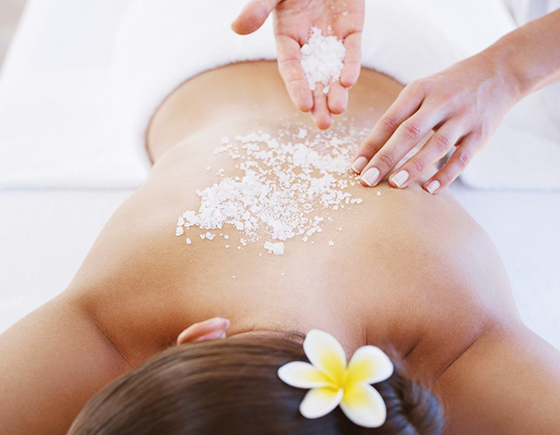
Full-Service Spa
- Beauty Salon
- Full-Service Spa
- Babysitting
- Infirmary/Medical Center
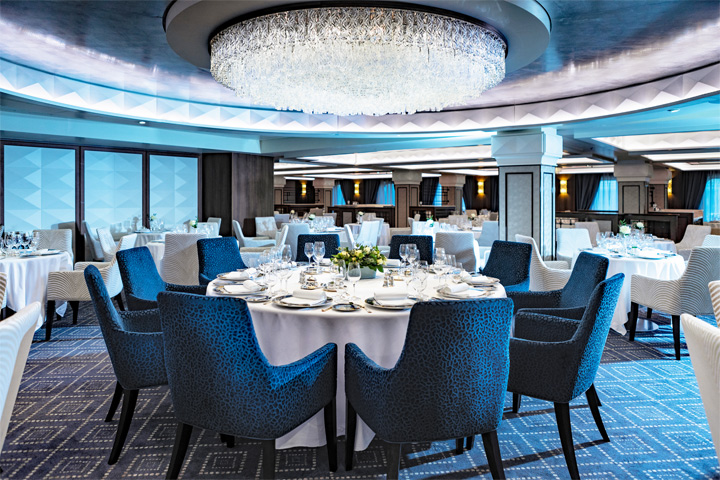
Compass Rose
Specialty Dining
Chartreuse: Featuring a classic French menu with a modern twist, Chartreuse evokes memories of a chic Parisian fine dining restaurant discovered during an evening stroll. Wherever you are seated in this regal restaurant, you will be treated to a succulent dinner while enjoying incredible ocean views. The restaurant ambiance is complemented by a menu that features dishes expertly prepared using both classic and modern techniques for a multiple course celebration of French gastronomy.
Compass Rose: Much thought was given to the design of Compass Rose, the flagship restaurant of Regent Seven Seas fleet. The dining room is outfitted with rich woods contrasted by light marble stones and mother of pearl shimmering brightly with an elegant color theme of light shades of blue, white, gold and silver. Compass Rose delights with a beautifully defined atmosphere and transitions from refreshing natural light during the day to a romantic ice blue lighting theme at night. This is the perfect setting for you to enjoy your breakfast, lunch and dinner, where the menu features an exceptional variety of Continental cuisine.
Prime 7: A true classic in every sense, Prime 7 sets a new standard in steakhouse fare with its contemporary interpretation of an American favorite. Handsomely decorated with supple leather wing-back chairs, burnished woods and rich earth-toned fabrics, Prime 7 exudes a distinct, intimate elegance. All the traditional starters are here, including Jumbo Lump Crab Cakes, Classic Steak Tartare, and Clam Chowder. Of course, beef is the undisputed star, and it is all USDA Prime and Dry-Aged at least 28 days to ensure the ultimate tenderness, juiciness and flavor. Prime New York Strip, Porterhouse Steak and succulent Filet Mignon only touch upon the selections. Mouthwatering alternatives include Alaskan King Crab Legs and Dover Sole. Prime 7 is open for dinner only and reservations are required.
Sette Mari at La Veranda: Each evening, La Veranda transforms into Sette Mari at La Veranda, a casual, intimate dining experience. Enjoy an extensive menu of authentic antipasti and Italian specialties served á la carte and paired with fine Italian wines — complimentary of course. Delectable dishes are prepared á la minute by talented chefs using only the freshest gourmet ingredients and served by attentive waiters. Sette Mari at La Veranda is open for dinner only.
Casual Dining
Coffee Connection: Your informal destination to relax, meet fellow guests and enjoy coffee and snacks throughout the day. While snacking, international newspapers and news magazines are available for your perusal.
La Veranda: Serving breakfast and lunch, La Veranda is exceedingly popular any time of the day. Spacious and comfortably casual, La Veranda offers regional specialties that often reflect the cuisines of the countries called on. Dishes are presented in a buffet style that displays the diversity of the menu. La Veranda also features an authentic pizzeria and a shaded, open-air veranda for dining al fresco.
Pool Grill: The Pool Grill is open-air, yet abundantly shaded for comfortable dining. Enjoy grilled-to-order burgers, grilled seafood, sandwiches, and fresh salads. Treat yourself to milkshakes and malts or an old-fashioned hand-dipped ice cream dessert sprinkled with all your favorite toppings.
Room Service: Complimentary 24-hour dining in the comfort of your stateroom.
Features a European king-size bed, a sitting area, a marble bathroom, a walk-in closet and a balcony. Concierge Level is available.

Category: H
Deluxe suite; 301 sq.ft.; 252 sq.ft.; Balcony: 49 sq.ft.

Category: G
Deluxe suite; 301 sq.ft.; 252 sq.ft.; Balcony: 49 sq.ft.

Category: F
Deluxe suite; 301 sq.ft.; 252 sq.ft.; Balcony: 49 sq.ft.
Spacious suites feature an in-suite iPad, daily canapés and upgraded bathroom amenities.
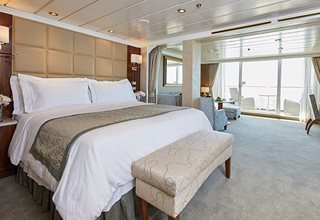
Category: A
Penthouse Suite includes Butler Service; 449 sq.ft.; 376 sq.ft.; Balcony: 73 sq.ft.

Category: B
Penthouse Suite includes Butler Service; 449 sq.ft.; 376 sq.ft.; Balcony: 73 sq.ft.

Category: C
449 sq.ft.; 376 sq.ft.; Balcony: 73 sq.ft.
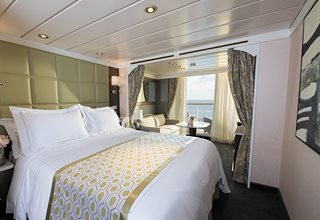
Category: D
Deluxe suite; 301 sq.ft.; 252 sq.ft.; Balcony: 49 sq.ft.

Category: E
Deluxe suite; 301 sq.ft.; 252 sq.ft.; Balcony: 49 sq.ft.
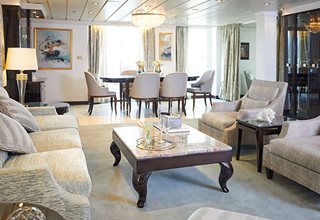
Category: MS
2 bedrooms; Master Suites include Butler Service; 2002 sq.ft.; 1204 sq.ft.; Balcony: 727 sq.ft.

Category: GS
Butler service; 987 sq.ft.; 903 sq.ft.; Balcony: 84 sq.ft.
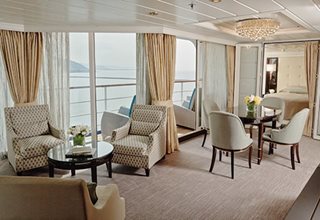
Category: MN
Mariner Suites include Butler Service; 739 sq.ft.; 650 sq.ft.; Balcony: 89 sq.ft.
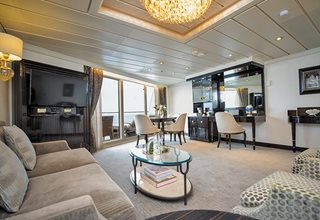
Category: SS
Seven Seas (forward) Suites include Butler Service; 602 sq.ft.; 505 sq.ft.; Balcony: 97 sq.ft.

Category: HS
Butler service; 627 sq.ft.; 359 sq.ft.; Balcony: 268 sq.ft.

| Symbol | Description |
|---|---|
 | Three guest capacity suite; convertible sofa bed |
 | Wheelchair accessible suites have shower stall instead of bathtub |
 | Bathroom features a glass-enclosed shower instead of a bathtub |
 | 2-bedroom suite accommodates up to 6 guests |
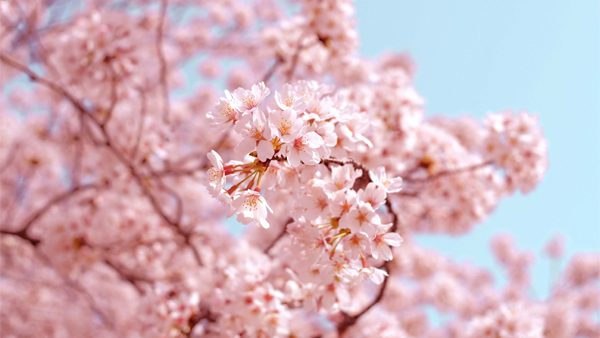
- Ship Name: Seven Seas Mariner
- Year Built: 2001
- Year Refurbished: 2018
- Year Entered Present Fleet: 2001
- Ship Class: Mariner
- Maximum Capacity: 700
- Number of Passenger Decks: 8
- Number of Crew: 445
- Officers' Nationality: International
- Tonnage (GRT): 48,075
- Capacity Based on Double Occupancy: 700
- Country of Registry: The Bahamas
- Total Staterooms: 350
- Suites with Balcony: 350
- Crew/Hotel Staff Nationality: European/International
Available Dates & Prices
Terms & Conditions
*Price shown is per person based on double occupancy, is valid for select stateroom categories only and does include government taxes/fees and gratuities. Click on Terms & Conditions link below for details.
**Select complimentary shore excursions are for full-fare guests only, capacity controlled and subject to availability. Shore excursion reservations are accepted on a first-come, first-served basis. Please note, available excursions vary by sailing date and day of the week. Government fees and taxes are included. Requested excursions may not be available at time of booking. Supplement will apply on Regent Choice excursions and excludes Private Arrangements and all Adventures Ashore programs. Restrictions apply and penalties apply 36 hours prior to shore excursion start date.
††All shipboard credit is in U.S. dollars, is per stateroom based on double occupancy, has no cash value, is nontransferable and not redeemable for cash.
†One Digital Costco Shop Card per room/stateroom, per stay. The exact amount of the Digital Costco Shop Card will be calculated during the booking process. The Digital Costco Shop Card promotion is nontransferable and may not be combined with any other promotion. A Digital Costco Shop Card will arrive by email approximately 10 days after the start of your cruise. Click on the Terms & Conditions link below for additional information.
Ship's registry: The Bahamas
Digital Costco Shop Card
This booking includes a Digital Costco Shop Card which will arrive by email one to two weeks after you return from your vacation. The Digital Costco Shop Card is a convenient payment option in our warehouses and on Costco.com.


















